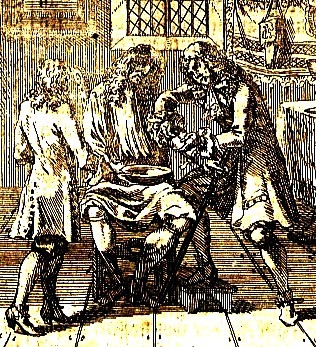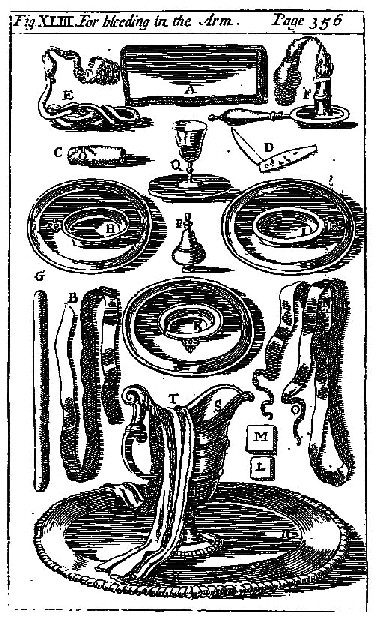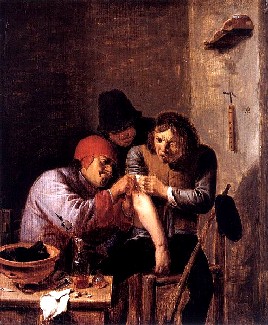
Bloodletting Procedure Page Menu: 1 2 3 4 Next>>
Bloodletting Procedure During the Golden Age of Piracy, Page 3
The Procedure to Let Blood
"After the Chirurgeon has hold of the Arm, the first thing he has to do, is to strip it to four Fingers
breadth above the Elbow; and if the Shirt Sleeve, or any other bind too hard, 'tis to be ripp'd because
'twould otherwise prove a Ligature, which stopping the Course of the Blood, would also hinder the Bleeding…
He then pins a Napkin under the Arm, which he turns over the Shoulder and Breast, that the Patient's
Clothes may not be spotted or stained with the Blood…" (Dionis, p. 367)

Bleeding woodcut by Wolf Holmhard von Hohburg, 1695
"The Arm thus striped, and the Napkin fixed, the Chirurgeon is, with the woollen Ligature is to bind it; this
Band ought to be [new?], that it may not be stained with Blood, and about or above three quarters of an Inch
broad, that it may bind without hurting the Patient, a narrower being apt to cut the Arm, and a broader not being
to be drawn tight enough: 'Tis to be of Cloth, which is neither too fine nor too coarse, either of which are
attended with their respective Inconveniencies.
Before we fix the Ligature, two things are to be observed; one, that the Arm be extended, and in the same Situation which it to be in before the Puncture; and the other, that the Hand be open and extended, and the Palm rests on the Chirurgeon's Breast, to prevent the Muscles of the Wrist swelling, and thereby altering the Situation of the Veins. We are then to fix the Ligature two Fingers breadth above the folding of the Arm, and the End of it which is to remain on the inside of the Arm is to be a little longer than the other, because 'tis to serve to make a Slip-knot, its two ends are to be rolled across on the back-part of the Arm, and after having rolled it a second time over the first winding we are to tye it on the outside of the Arm in a single Bow-knot, with the Loop upwards, and the two ends hanging down on the back-part of the Arm.
This first time we are not to draw the Ligature any tighter than is requisite to bind it on the Vein and stop the blood in the Wrist or fore-part of the Arm, without closing the Artery, which is to furnish the Veins with Blood, in order to make them rise and to procure the better Communication of that Liquor [the blood], we are to cause the Arm to be return'd into the Bed, and if necessary wrapt up in a very hot Napkin." (Dionis, p. 367-8)
"During this Repose of the Patient, the Chirurgeon takes out of his Lancet-case C, the Lancet D, which he
judges fit to open the Bein, for there are broader and narrower to be made us of according as the Case requires:
There are also others, whose Points are very fine, which are adapted to nice and tender Skins, and others with those called Barley-corn Points, design'd for those who have a hard and dry Skin. The Lancet thus fixed on, '
tis to be opened so as not to make an acute, but an extended obtuse Angle, as is that mark'd D; this he puts
into his Mouth, turning the Point to the left, when he is to bleed

Dionis' Tools for Bleeding (p. 356)
the right Arm and to the right when to perform
that Operation on the left; which he is to observe I, in order to take that Instrument the more commodiously. He is
next again to take hold of the Arm, which he is to extend and rest on his Breast as before; he is next to shut the
Paitient's Hand, with his Thumb within his Fingers, that the Muscles by that Action swelling, may the better
raise the Veins. As for my part, as soon as I have chose my Lancet, I put my Lancet-case into the Patient's
Hand for him to hold instead of grasping his Thumb, and it produces the same Effect: This Case must also be given
him to turn it in his Hand after the Orifice is made; so that 'tis gaining of Time, the Patient turning it as
soon as the Blood comes, without being oblig'd to ask for it.
He that is instrusted with the Candle, is to be placed on the Left-side of the Chirurgeon, near the Bed's head: If the Operation is to be perform'd on the Right-arm, he is to hold it with the Left-hand, and withal a Plate, in which is a Porrenger in his Right, which he is to hold under the Patient's Arm, to receive the Blood as soon as it issues out. 'Tis the Chirurgeon's Place to dispose the Candle, of which there are two sorts, the large wound Wax-candle E, and the other in the Candlestick F, both which are equally proper. He then places his Light, either on the in or outside of the Arm, according as he thinks most convenient, with regard to the Point of Sight; after which he is to examine the Veins, in order to choose that which he shall conclude most fit to be opened.
There are four Veins in the Arm which we may open: The first is the Cephalic Vein, so called, because being the highest 'tis nearest the Head: The second is called the Median Vein, from its situation in the Middle of the Arm: The third is [?] nam'd the Basilical, from its taking up the Basis of the Arm: and the fourth the Cubical, because nearest to the Elbow. The Median and Basilical Veins are those which are generally bled, because they are larger and more commodious, as well to open as ot draw out the Blood; but they are also the most dangerous. The Basilical Vein is often so near the Artery, that we ought to be very cautious that we don't open the latter with the former; and the Median being placed on the Tendon of the Biceps, requires the Chirurgeon's utmost Address to avoid it: For the artery and Tendon are two Rocks, on which unfortunate Operators split.
...
'Tis not enough to have pitch'd on the Vein, we are also to determine where we are to open it, which ought to be always in the Place where it rises or appears best, and below the Scars of former [vene]Sections. For if we should make the Orifice above them, the Blood would not issue out so well, by reason that these Cicatrisings having contracted the Vein, it cannot come out so freely as below, where the Vein is of a larger Diameter. For this Reason a Chirurgeon who is desirous to spare an Arm which he is used to bleed, will begin with opening it as high as he can; then descending always lower, he will place his Orificices near one another, and so bleed the Patient well, and besides keep a Reserve of Space, which he will find in proper Time and Place.
When the Chirurgeon has fixed on the Place which he designs to prick, he is to mark it with his Nail, not only with one, but two Dents, the one above and the other below the Vein, and distant from one another, as near as he can judge, the Thickness of that Vessel, in order to make the Orifice from one Mark to the other: That done, he is again to straiten [tighten] the Ligature, in order to hold the Skin of the Arm tighter; and in this Case 'twill not signify much to press the Artery, the Vein being sufficiently risen; next the Chirurgeon is to rub the Patient 's Wrist and Fore-part of the Arm with his Right-hand, from the lower Part upwards, to cause the Blood to mount in the Vein, towards the Hand, and lastly, before he takes the Lancet, which he holds in his Mouth, he touches the mark'd Place with his Fore-finger, to examine whether the Motions he has been making have not changed its Situation.
If he finds the Vein in the same State, then without turning his Eye off that Place which he has mark'd, he takes his Lancet, which he holds betwixt his Fore-finger and Thumb, by the Middle of the Blade, in order to hold it the more steady, then approaching the Arm, he lays on it the Ends of his other Fingers, to prevent his Hand shaking at the Time of the Punction: His Hand being secure he brings the Lancet nearer the Place to be opened, and placing it on the lower Mark, which is below the Vein, he thrusts it on 'till he is sure that 'tis in the Vein, and in withdrawing raises it, that is, he cuts the Skin as far as he judges necessary to bleeding well: The more or less, according to the bigness of the Vein, and the Heat and Vivacity of the Blood.

Feeling by Adriaen Brouwer, 1635
The Orifice in a Vein may be made three ways, either longitudinal or long-ways, a-cross and obliquely, the last of
which is to be preferred to the others, as well on Account of its being most convenient for the Operator, as
because 'tis better for the Patient, it enlarging the Orifice, which facilitates the coming out of the Blood.
To open a Vein well, no more than the two Fingers which hold the Lancet ought to act, they are bent when they
convey the Lancet to the Vein, and the Hand being then rested on the other Fingers, which are sustained by the
Patient's Arm, the Lancet enters the sole extending of the finger and Thumb, an dis drawn out by the same. If
a Chirurgeon should make use of his whole Hand to make such a light Orifice, 'twould with Reason be said of
him, that he had a heavy Hand.
The Aperture comprehends two Times, that of the Punction, and that of the Elevation: The first is the Time which is requisite to make the Lancet's Way from without inwards; and the second, the Time required to make its way from within out again: When the Lancet enters, it cuts with both its Edges; but when it comes out with only the upper Edge, which we withdraw, raising it a little. There are some who add a Time of Incision, which they place betwixt the two others; but 'tis an unnecessary Multiplication of Beings, it being impossible for the Punction and Elevation to be performed without Incision.
As soon as the Blood spurts out, the Chirurgeon folding in his Lancet, lays it at the Edge of the Plate which holds the first Porrenger, in order to find it again the more easily: For should he lay it on the Bed, it might fall and spoil, or else he might have the Trouble of looking for it on the Cloth which covered the Bed, which the Servants may have carried away. If the Candle is held at the inside of the Arm, we are not to pull it back under it, fo fear of burning the Part; but on the contrary thrust it towards the middle of the Bed, to shew the streaming out of the Blood. But some Patients will hold the Candle themselves, which the Chirurgeon is not to oppose, as well because he sees better what he does, as that it employing the Patient in some measure, thereby prevents his fainting so soon." (Dionis, p. 368-71)
"When the first Porrenger H, is almost full, we call for the second I, which is to be held under the first, that when the former is taken away, the Blood may fall into the second; and so in like manner the third K, is to be used; and whilst the last is filling, we cause the Band and Bolsters to be brought: He that carries the Porrengers of Blood from the Bed to the Table, must take care to go easily, in order to avoid spilling of any of it on the Place; and also to set them in the same Order that they were fill'd.
To stop the Blood, the Chirurgeon is to loosen the Ligature, withal taking care that the end of it don't fall into the last Porrenger, which we don't usually order to be taken away before the Ligature is taken off, and we become Masters of the Blood [stop the bleeding]. To render himself Master of the Blood, the Chirurgeon claps the fore and middle Finger of the Left Hand on the Orifice: Then with these two Fingers he moves the Skin in a little Send-circular manner, by which the Blood is stopp'd without so much as a single Drop coming out.
Which done, the Porrenger is be carried to the Table to be set in its Place amongst the others.
The Chirurgeon next takes the little Bolster L, in his Right Hand, and before he lays it on, he is to take off his two Fingers which keep the Orifice in Subjection, in order to allow it to discharge ea little Blood; then placing them there again, he a second time stops the Blood, and immediately lays the Bolster on the Orifice, on which he afterwards lays a second Bolster with the Corner of a Napkin wetted, he dries up the Blood which may have stain'd or spotted the Arm: Then over the Bolsters he fixes on the Band N, at six Fingers breadth from one of the its ends, which he causes to hang behind the Arm, rolls it in a circular manner above the Elbow, and then compassing it over the Orifice, he makes another Bandage on the Wrist, which he continues always crossing over the Bolsters, as many Times as the Length of the Ligature will allow. He then ties the two ends, O O behind the Wrist, or fore-part of the Arm; and that the Bolsters may not slip off in the Night, he fastens them to the Band with a Pin. He next cover the Arm again, by drawing down the Shirt and Waistcoat sleeve, and bending the Arm, lays it in the Bed, injoining the
Patient to hold it so bent on his Stomach, less stirring it, the Orifice should chance to bleed afresh. " (Dionis, p. 372-3)

